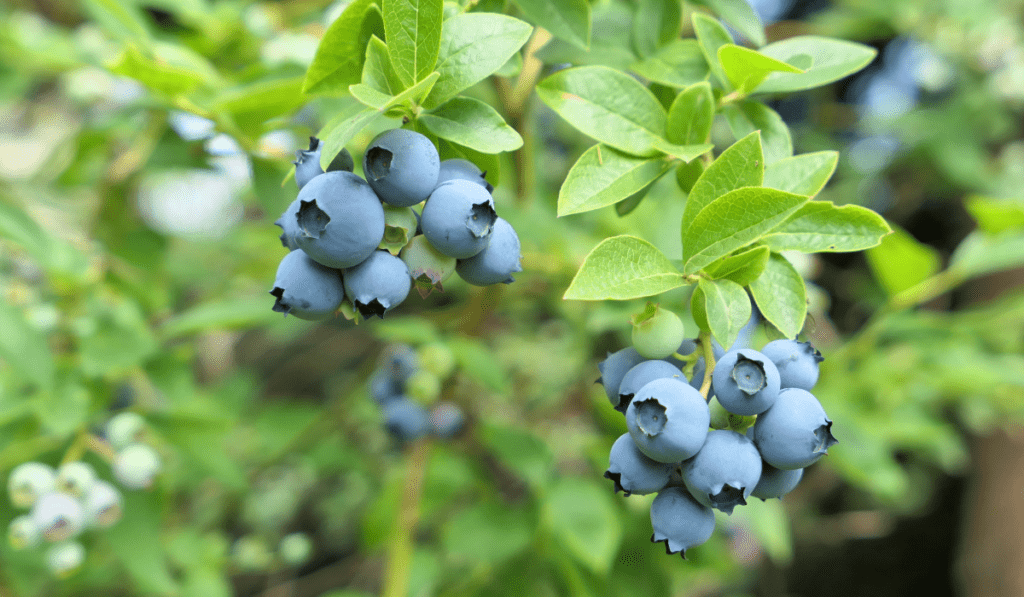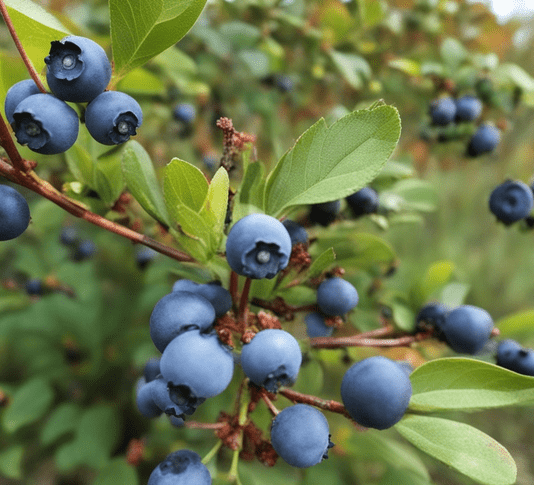Have you ever dreamed of cultivating your own sweet, juicy Highbush Blueberries at home? Wondering where to start and how to ensure a thriving berry patch?
In this comprehensive guide on “How to Plant Highbush Blueberries,” we’ll unravel the mysteries, answering your questions from choosing the perfect location to enjoying a bountiful harvest.
Join us on this journey, and by the end, you’ll not only be a Highbush Blueberry expert but also relishing the rewards of your homegrown harvest.
Choosing the Right Location for Planting Highbush Blueberries
Introduction: Setting the stage for success begins with selecting the right location for your Highbush Blueberries. Let’s explore the key considerations:
Sunlight Exposure: Highbush Blueberries thrive in sunlight. Choose a location with at least 6-8 hours of direct sunlight to ensure optimal growth and sweet berry development.
Air Circulation: Promote a healthy environment by selecting a site with good air circulation. This helps prevent diseases and ensures robust growth.
Soil Drainage: Optimal drainage is critical. Pick a well-draining site to prevent waterlogged roots and potential issues like root rot.
Elevation and Frost Protection: Consider the elevation to avoid frost damage. Planting on slopes can minimize the risk of cold air pockets, offering natural frost protection.
Structural Support: Highbush Blueberries may need support as they grow. Installing trellises or other supports can keep the plants upright and facilitate easy harvesting.
Microclimates: Understand microclimates in your garden. Tailor the planting site to your Highbush Blueberries’ preferences by placing them in areas with unique temperature and moisture characteristics.
Preparing the Soil for Planting Highbush Blueberries
Meticulously preparing the soil creates an ideal environment for highbush blueberries. Follow these steps for optimal soil conditions:
- Early Preparation: Clear debris and weeds early to create a healthy blueberry patch, setting the stage for robust growth.
- Incorporating Organic Matter: Enrich the soil with compost or manure for essential nutrients, ensuring vigorous growth and a bountiful harvest.
- Soil Test: Conduct a soil test to understand composition, enabling informed decisions about nutrient adjustments and pH balancing.
- pH Adjustment: Balance soil pH using amendments like sulfur or lime, as highbush blueberries prefer slightly acidic to neutral soil.
- Enhancing Drainage: Improve drainage with perlite or coarse sand to prevent waterlogging, supporting overall plant health.
- Weed Control: Maintain a weed-free zone around highbush blueberries to reduce competition for resources and prevent pests.
Selecting and Purchasing Highbush Blueberries Plants
Unlock a thriving blueberry patch by choosing the right highbush blueberry plants. Follow these steps for success:
- Check Plant Health: Examine plants for signs of disease or pest damage, opting for vibrant leaves and robust stems.
- Root System Inspection: Choose plants with well-developed root systems, as healthy, white roots indicate a robust plant ready for transplantation.
- Varietal Selection: Select highbush blueberry varieties from reputable nurseries, ensuring they suit your climate and garden conditions.
- Planting Highbush Blueberries – Step-by-Step Guide:
Embark on the journey of planting highbush blueberries in your garden with this step-by-step guide:
- Selecting Quality Plants: Choose healthy plants free from diseases or pests, ensuring quick establishment and a thriving blueberry patch.
- Timing is Everything: Plant in late fall or early spring when the soil is workable, avoiding extreme temperatures to minimize stress on the plants.
- Digging the Perfect Hole: Create holes large enough to accommodate root systems, ensuring proper spacing for optimal growth and air circulation.
- Planting Depth Matters: Set plants at the same depth as in nursery containers for healthy root development and overall plant vigor.
- Mulch for Moisture Retention: Apply organic mulch around plant bases to retain moisture, suppress weeds, and regulate soil temperature.
- Watering: Ensure consistent soil moisture during the establishment period, supporting healthy root system development.
- Support Structures: Install trellises or stakes for growing canes, providing proper support for an organized and accessible blueberry patch.
- Monitor and Adjust: Regularly monitor soil moisture and adjust watering based on weather conditions, ensuring consistent moisture for highbush blueberries.
- Prune for Growth: Guide blueberry bush growth by pruning strategically, promoting a healthy structure and optimal fruit production.
Caring for Highbush Blueberries
Once planted, caring for highbush blueberries is essential for a successful harvest. Explore these crucial care practices:
- Watering: Maintain consistent soil moisture, especially during dry periods, to support healthy growth and fruit development.
- Fertilizing: Apply a balanced fertilizer in spring to provide essential nutrients for vigorous growth and bountiful harvests.
- Mulching: Renew mulch annually to retain moisture, suppress weeds, and regulate soil temperature around highbush blueberries.
- Pruning: Prune dead or damaged branches annually to encourage new growth and maintain an open, productive canopy.
- Training and Support: Provide ongoing support to growing canes, ensuring they are well-supported and organized for efficient harvesting.
- Pest and Disease Monitoring: Regularly inspect plants for pests and diseases, taking prompt action to protect your highbush blueberries.
- Harvesting Practices: Harvest ripe berries gently to avoid damaging the plant, and use proper techniques for the best flavor and quality.
- Winter Preparation: Prepare highbush blueberries for winter by applying a layer of mulch to protect the roots from cold temperatures.
Pruning and Training Highbush Blueberries Plants
Pruning and training are crucial for maintaining healthy, productive highbush blueberry plants. Follow this detailed guide:
Pruning Steps:
- Remove Dead or Diseased Wood: Begin by cutting out any dead or diseased wood to promote overall plant health.
- Thinning Out Branches: Thin out crowded branches to improve air circulation, reducing the risk of diseases.
- Encourage New Growth: Cut back older branches to encourage new, productive growth, ensuring a continuous harvest.
Training Techniques:
- Trellising: Use trellises to support canes and encourage an organized growth structure for easy maintenance.
- Staking: Stake tall or leaning branches to maintain an upright position and prevent breakage.
- Regular Pruning Schedule: Adopt a regular pruning schedule, typically in late winter or early spring, to keep the plant in optimal condition.
- Ongoing Monitoring: Continuously monitor the plant’s growth and adjust pruning techniques accordingly for a well-shaped, productive highbush blueberry.
Common Pests and Diseases of Highbush Blueberries
Protect your highbush blueberries from common pests and diseases. Learn to identify and implement preventive measures:
- Aphids: Identify aphids by their small size and various colors. Use insecticidal soap or introduce natural predators like ladybugs.
- Blueberry Maggots: Monitor for small, white maggots in berries. Implement insecticides and proper fruit hygiene to prevent infestations.
- Botrytis Blight: Recognize gray mold on berries and stems. Prune affected areas and apply fungicides during wet conditions.
- Mummy Berry Disease: Identify shriveled, tan berries. Apply fungicides in early spring and practice good sanitation to control mummy berry disease.
- Powdery Mildew: Look for white powdery spots on leaves. Apply fungicides and ensure proper spacing for good air circulation.
- Scale Insects: Identify scale insects as small, immobile bumps on branches. Use horticultural oil to control infestations.
How to Harvest Highbush Blueberries
Harvesting highbush blueberries is a rewarding culmination of your efforts. Follow these guidelines for a successful harvest:
- Harvest When Ripe: Pick berries when they are fully ripe, usually turning a deep blue color. Ripe berries are plump, firm, and flavorful.
- Gentle Harvesting: Harvest berries gently to avoid damaging the plant. Use a light touch to pluck ripe berries without harming the stems.
- Proper Techniques: Hold the cluster of berries and gently roll them off the stem. Avoid pulling, which could damage the plant.
- Frequent Harvests: Harvest frequently to ensure you pick berries at their peak ripeness, promoting continuous fruit production.
Conclusion:
cultivating highbush blueberries is a rewarding journey that promises not only delicious, homegrown berries but also the joy of tending to a thriving garden. From selecting the right location to nurturing the plants through care and harvest, this guide equips you with the knowledge and skills needed for a successful blueberry patch. Whether you’re a seasoned gardener or a novice, follow these steps, and soon you’ll be savoring the sweet taste of success in your very own highbush blueberry haven. Happy gardening!



